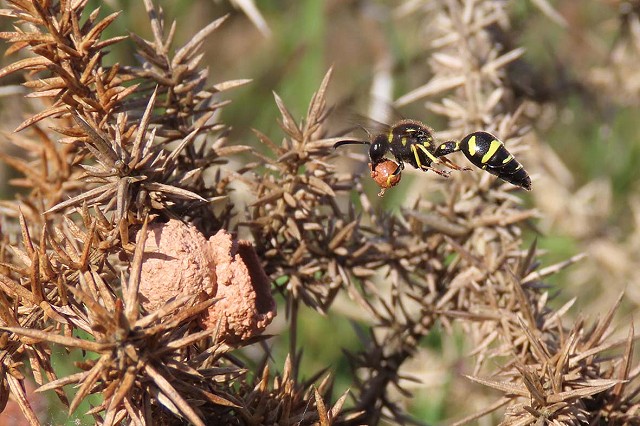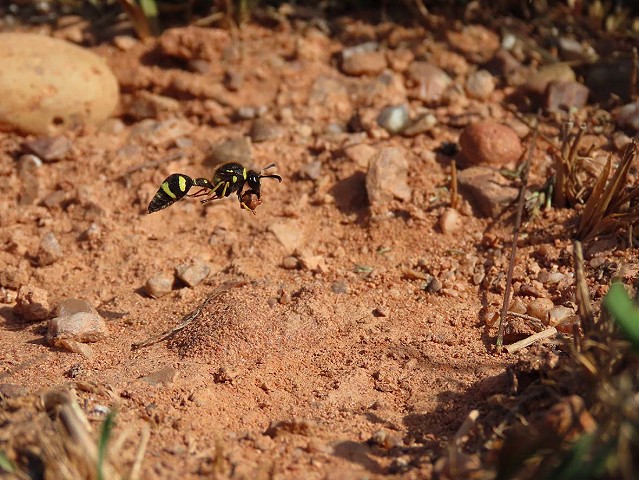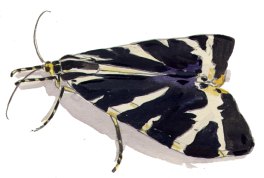I first encountered this insect whilst filming with wildlife cameraman Martin Dohrn on Stoborough Heath in Dorset in August 2007. We managed to find the wasps collecting mud and carrying it off across the heath but failed to find one building its pot despite considerable efforts to do so.
After seeing the beautiful mud pots attached to heather I was determined to see how they were built. A four-year quest searching sites in Dorset and east Devon eventually led to me seeing one build a pot on Bovey Heathfield just a few miles from home in August 2010.
I am currently conducting an extensive study of the wasp at Bovey Heathfield with Pat Carter. The wasps fly from May to early October in two broods. In 2011 these flew from May to early August and late July to early October. During the wet summer of 2012 the first brood wasps were active well in August with one still building in September and only a handful of second brood wasps emerged. In 2013 there was a reasonable second brood with wasps active until late September. 2014 has been an exceptional year for the wasp, despite many pots being lost in the stormy wet conditions over the winter. At my main study quarry on the heath 3 females were seen from June to late August but the excellent weather in June led to a large second brood. 13 females used the quarry from late July until early October.
The wasps are only active in warm weather. The female selects a suitable ‘quarry’ site and a water supply – a pond or puddle and uses these for all her pots. Each female probably builds about 25 pots in her lifespan of two to three months. The distance the female travels from the quarry to build varies between 1 and 120 metres, they appear to travel further in hot conditions. The construction of each pot follows the same pattern.

First the female flies to the quarry and water sites but does not collect mud. Instead she flies out into the heather and gorse flying slowly and stopping frequently to examine the stems of heather, gorse and dead grasses. When she has selected a site she cleans the stem with her jaws and sometimes wets it with saliva to remove any loose material. She then returns to her water source then visits the quarry and starts scraping at the clay with her jaws. Adding water to the dry clay she is able to make a small mud ball in a couple of minutes. This is held between her jaws and front pair of legs as it is transported to the construction site where building commences. This process is repeated with occasional trips to collect water between 16 and 28 times until the pot is completed. This takes between 2 and 3 hours though this can be spread over several days if weather conditions are poor.

When the neck and lip of the pot are completed the wasp rests in the heather nearby for a few minutes then returns to lay an egg in the pot. The egg is suspended inside the neck of the pot on a strand of silk. Egg laying takes about two minutes. Then the wasp flies out on to the heath to search for small caterpillars, particularly those of pug and horse chestnut moths which feed on heather and gorse flowers. Between 8 and 38 caterpillars are brought back to the pot usually at a rate of about one an hour. When the pot is full the wasp collects water and returns to the quarry. One or occasionally two balls of clay are then used to seal the pot. The wasp usually starts searching for a new location to build her next pot but occasionally (especially in September) she will build a pot adjacent to the first. Sets of up to eight pots have been recorded.
Pots built before the end of June produce adults the same year and those built in early July up to 10th may emerge in the same year, pots built after this will over winter and emerge the following year.
Potter wasp videos:
- Part 1
- Part 2
- Heath Potter Wasp bringing in caterpillar 2010
- Heath Potter Wasp and Common Lizard
- Heath Potter Wasp cleaning stem before building pot
- Heath Potter Wasp bringing in caterpillars to nest
- Heath Potter Wasp nest building timelapse
References
- Walters, J. 2010. Observations of the Heath Potter Wasp Eumenes coarctatus in Devon. BWARS Newsletter Autumn 2010 pages 21-27.
- Walters, J. 2010. The Heath Potter Wasp Eumenes coarctatus in Devon. Bulletin of the Peninsular Invertebrate Forum. Issue 20, October 2010 pages 10 - 13.
 Skip To Content
Skip To Content